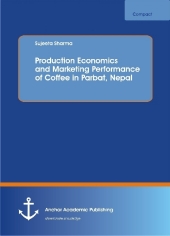 Neuerscheinungen 2016Stand: 2020-02-01 |
Schnellsuche
ISBN/Stichwort/Autor
|
Herderstraße 10
10625 Berlin
Tel.: 030 315 714 16
Fax 030 315 714 14
info@buchspektrum.de |

Sujeeta Sharma
Production Economics and Marketing Performance of Coffee in Parbat, Nepal
2016. 44 S. 17 Abb. 220 mm
Verlag/Jahr: ANCHOR ACADEMIC PUBLISHING 2016
ISBN: 3-9606709-6-6 (3960670966)
Neue ISBN: 978-3-9606709-6-4 (9783960670964)
Preis und Lieferzeit: Bitte klicken
Coffee is one of the most important cash generative crops in the mid hill regions of Nepal. This study examines the production economics along with marketing performance of coffee in Pakuwa VDC of Parbat district, Nepal. The Survey was done in June 2014. Data collection was conducted through semi-structured pre-tested questionnaire administered on 40 farmer respondents selected randomly. Gross margin analysis, profitability index and the benefit-cost ratio (B-C ratio) were used to analyze the production economics of coffee in the study area.
Text sample:
Chapter 3 RESEARCH METHODOLOGY:
This section includes different methodological framework for research procedure which consists of four main sub-sections. The first section describes the conceptual framework of the study. Second section describes the sampling procedure, sample frame, sample size and survey design. Third section describes data collection procedure and data analysis techniques are described in detail in the fourth section.
3.1 Selection of the study area:
Pakuwa VDC of Parbat District of Nepal was selected for the study. Parbat District is a mid hill district of Western Development Region of Nepal lies between 28000´19´´North-28023´59´´North latitudes and 83033´40´´East- 83049´30´´East ´longitudes with total area of 536.86 sq. Km (DADO, 2013). Out of the cultivated land only 11.96% is under year-round irrigation and 4.94% is seasonal irrigation. The average land holding of the district is 0.8 hectare per family. A total area of 59 ha is under coffee farming which is increased by 25.53% and total production of 12tons of coffee out of which Pakuwa VDC comprise 5 tons of production.
The reasons for purposive selection of the VDC are involvement of most of the farmers in coffee plantation from long time, from market modality perspective and the researcher´s accessibility.
3.2 Sampling procedure and selection of the respondent:
The size of the sample and amount of variation, usually affect the quantity and quality of information obtained from the survey. Using appropriate sampling methods, both factors can be controlled (Scheaffer, 1979).
3.2.1 Sampling method:
Sampling theory provides an opportunity to minimize cost and to achieve acceptable results (Casley and Kumar, 1988). However, a sampling procedure involves the following steps: defining the population, sample frame, sample size and sample selection procedure.
3.2.2 Defining the population:
The coffee farmers of Pakuwa VDC in Parvat district who have long experience in coffee production were taken as the sample population for this study.
3.2.3 Sampling frame, sample size and sample selection procedure:
The sampling frame was prepared with the Key informants of the respective District and VDC. Yearlong coffee producers in Pakuwa VDC of Parvat district constitute the sampling frame for this study. Total sample of 40 farmers cultivating coffee were selected randomly for the study.
The best way to avoid bias in the sample selection process is use of simple random sampling in which each unit of the population has an equal chance for selection (Scheaffer, 1979). Thus by using sampling frame, a simple random sampling procedure was used to collect necessary information.
3.3 Methods and techniques of data collection:
Various sources and technique were used for collection of necessary information. The methodologies consisted of field survey, review of previous studies, focus group discussion and also direct observation by the researchers.
3.3.1 Sources of information:
The pre-tested interview schedule was administered to the respondents to collect primary information. All randomly selected participants were visited and interviewed. Primary data were also collected through Focus Group Discussion (FGD). Secondary information were collected from the various published materials like bulletins, books, journals, research articles, publications from district offices of respected site, proceedings of various NGOs and INGOs, reports of District Agriculture Development Office (DADO), reports from the Ministry of Agriculture and Development (MoAD), reports of District coffee producers association (DCPA), publications of National Tea and Coffee Development Board (NTCDB), Coffee Cooperatives etc.
3.4 Survey design and data collection procedure:
3.4.1 Reconnaissance Survey:
It was a informal survey on which the researcher himself carried out a field visit of the study area with the objective to become familiar with different features of the study area


